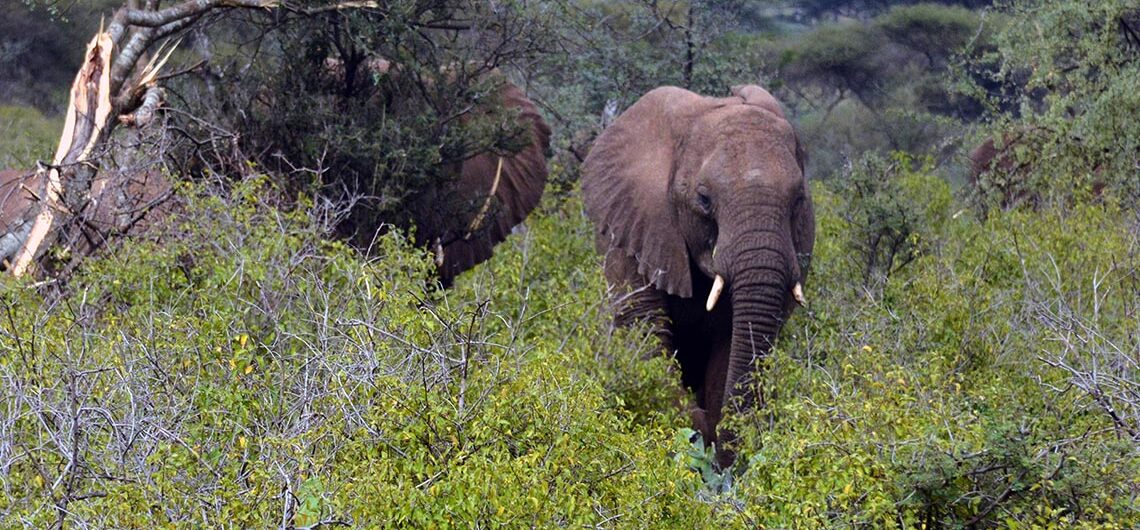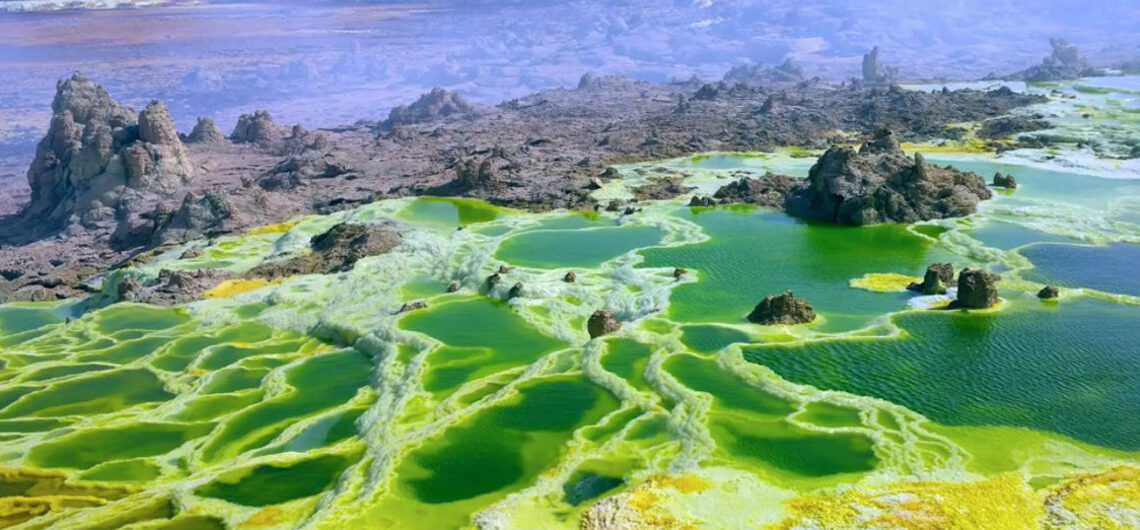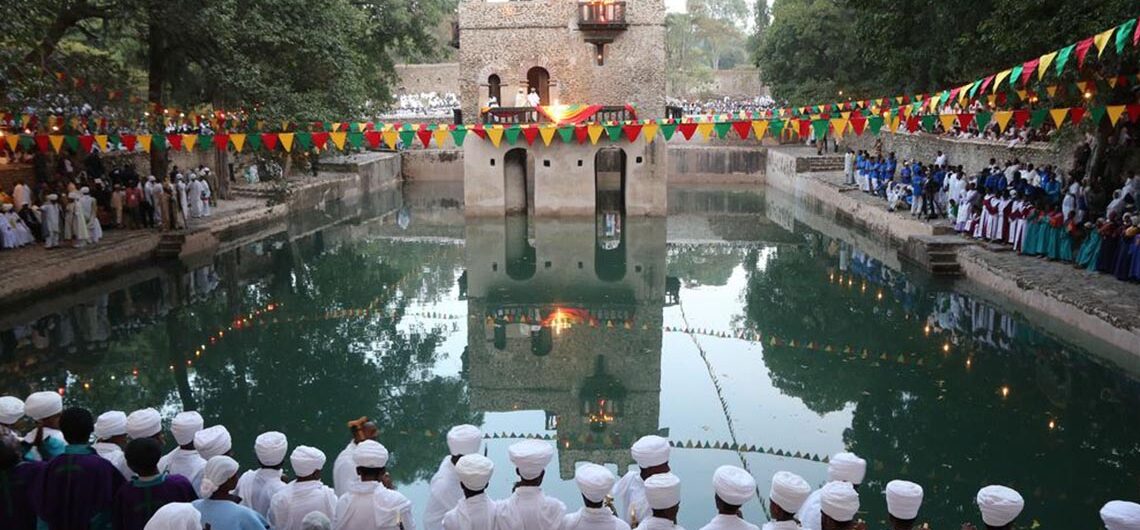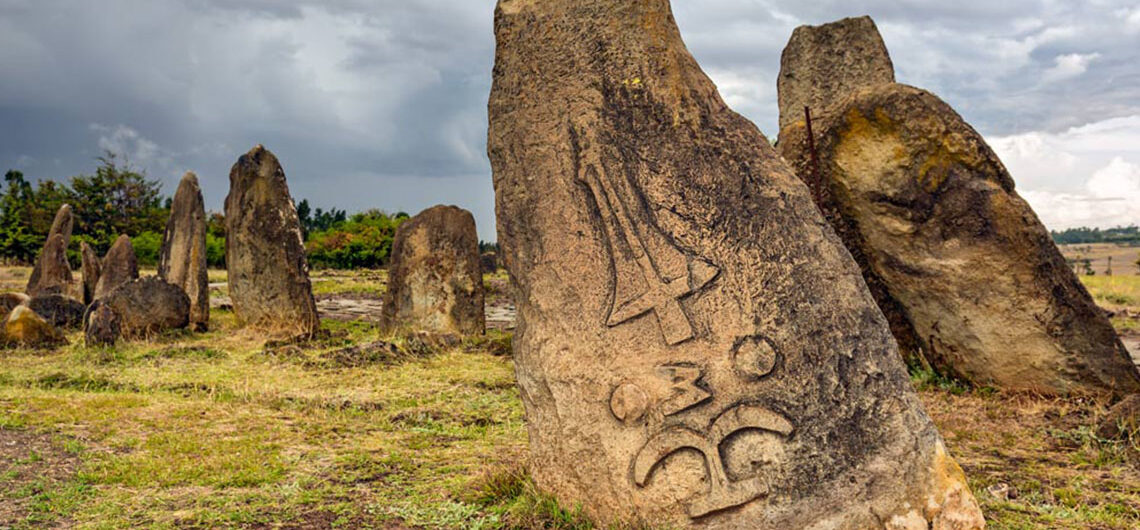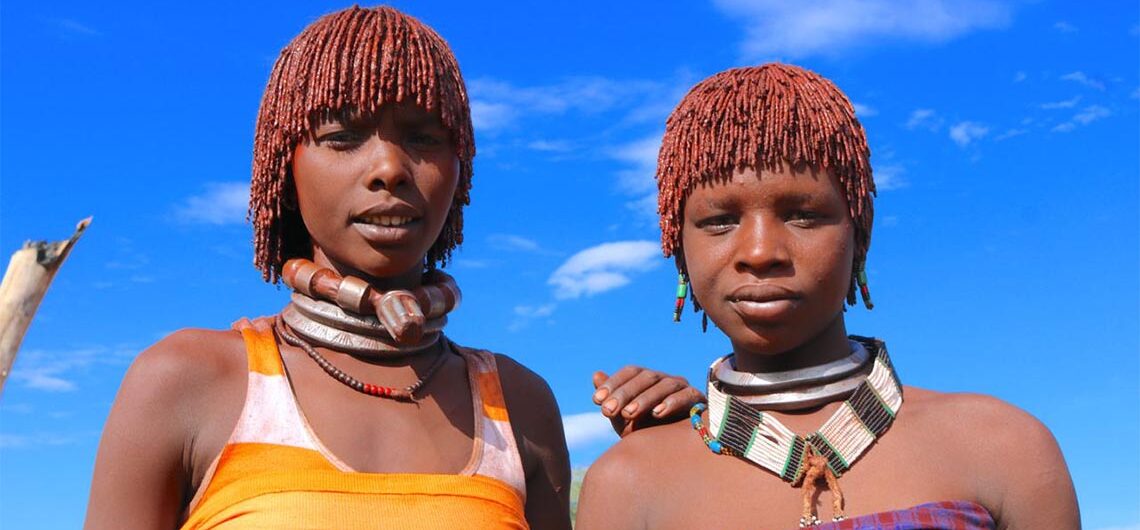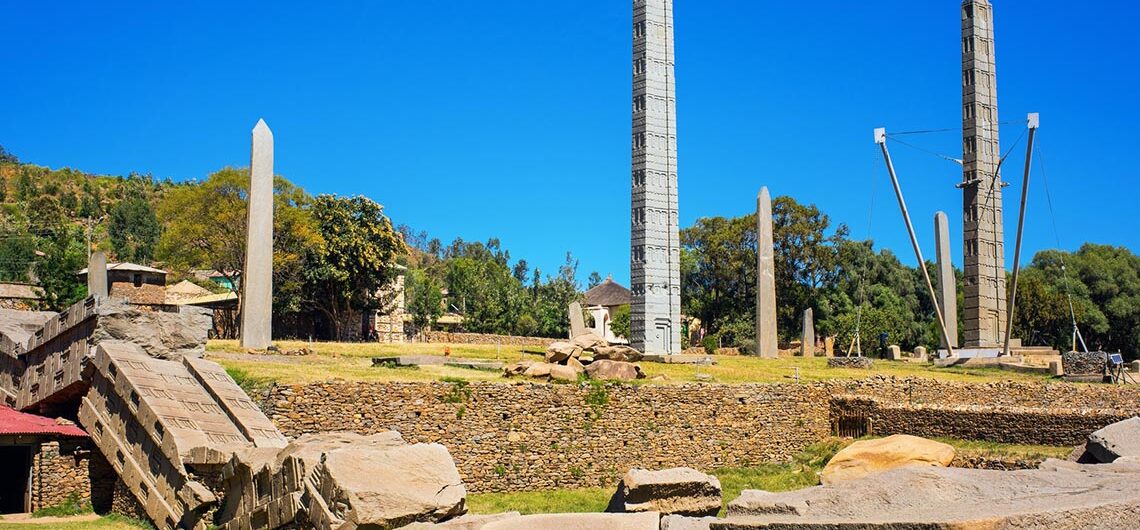Extending over almost 7,000 square kilometres to the southeast of Harar, Babile Elephant Sanctuary is a vast and spectacular reserve comprising wide gorges flanked by open plains, rocky out-crops, meandering river beds and, in the south and the east, a drier almost-desert like landscape. Babile is home to Africa’s most north-easterly population of elephants, which some authorities assign to a unique race Loxodonta africana orleansi, endemic to the Horn of Africa. The sanctuary also provides refuge to thin populations of the localised black-maned Abyssinian lion and greyhound-like cheetah, along with various antelope (including greater and lesser kudu), the hamadryas baboon, and a spectacular selection of dry-country birds, including the endemic Salvadori’s serin. An estimated 200 elephants inhabit Babile, moving seasonally between the Erer and Gobelle river valleys, but also sometimes venturing outside the sanctuary to the western ridge of the Gobelle Valley. The best time of year to visit is the late rainy season (June to September) when the elephants usually congregate in the Upper Erer Valley about 40km from Harar.
Set at the juncture of three tectonic plates, the Danakil is one of the world’s lowest-lying places, set mostly below sea level, and it officially ranks as the hottest inhabited place on earth, with an average daily maximum of 41°C. Much of the region comprises sun-cracked salt-flats that stretch like blinding-white crazy paving towards a shimmering flat horizon. However, the high level of tectonic activity means that more than 30 active volcanoes protrude from this stretch Great Rift Valley floor. These include the iconic Erta Ale, which has hosted a permanent lava flow since the late 19th century, and the Dallol Crater with its sulphurous pools enclosed by strange pastel-hued crystalline formations.
The Danakil’s top attraction is Erta Ale, a 613m-high shield volcano whose caldera of crumbling black rock contains world’s oldest permanent lava lake. Bubbling at temperatures of more than 1,000˚C, this ellipsoid cauldron of black-and-red magma is a truly mesmerising phenomenon, as violent red fountains of molten rock spurt tens of metres in the sky, accompanied by nose-searing waves of ammoniac gas. Accessible only on foot or by camelback, Erta Ale is reached along a gradually sloping 10km path through shadeless terrain that can be treacherously hot in full daylight. It is conventional to ascend in the late afternoon to avoid the midday heat, then sleep at the top and return to the base early the next morning.
Set in a flat-sided shallow explosion crater, the Dallol Springs comprise a field of multicoloured geysers that bubble over into a series of steaming sulphurous pools dotted with conical yellow-green vents and crystalline formations of red, orange and white. It is especially beautiful in the early morning and late afternoon, which is also when the temperature is most bearable.
Once a bay in the Red Sea, the hyper-saline Lake As Ale lies at the heart of a 1,200km2 expanse of salt-encrusted flats that have been mined by the local Afar for millennia. Even today, visitors might come cross dozens of Afar miners chipping at the salt flat’s crumbly off-white crust to extract neat 30cm x 40cm amole salt bars. The salt is then transported by camel to the highlands by caravaneers from Tigray.
Set at 103m below sea level, the lovely emerald-hued Lake Afdera laps the shore of what is regarded to be the world’s lowest-lying island. Now accessible on an asphalt road that runs through the village of Afdera, the lake is an important source of salt, which is obtained from artificial evaporation pools along the western shore. You can swim or camp at a set of freshwater hot springs on the west shore close to Afdera village
Many tourists to Ethiopia try to time their visit to coincide with the colourful festivals of Meskel, Timkat or Enkutatash.
- Now registered with UNESCO as an element of the Intangible Cultural Heritage of Humanity, Meskel (27 September) commemorates the alleged 4th century discovery of the True Cross on which Jesus was crucified. The centrepiece of this uniquely Ethiopian festival is the burning of a massive conical pyre called a Damera. The largest ceremony takes place in Addis Ababa’s Meskel Square, where hundreds of thousands of people gather to watch the colourfully dressed priests chant, pray and dance. The most historically poignant site to witness Meskel is Aksum’s Cathedral of Maryam Tsion.
- Timkat, the Ethiopian Orthodox equivalent to Epiphany, is celebrated at churches throughout the country on January 19. The best place to be during Timkat is Gondar, where the festivities culminate in a crowded and colourful afternoon re-enactment of the first baptism at the 17th century Fasil’s Pool, which is filled with water for the occasion.
- Gena or Ledet (7 January), the Ethiopian equivalent to Christmas, is preceded by an all-night vigil following 43 days of fasting that culminate. It is a family-oriented holiday, but in some areas it is marked by traditional dancing or a hockey-like game called Yegenna Chewata, supposedly played by the local shepherds on the night Jesus was born. It is traditional to eat the national dish doro wot (chicken stew) over Gena.
- The usual Islamic holidays are celebrated in Ethiopia, especially in and around Harar. At the end of the fasting month of Ramadan, the first day of the month of Shewal is celebrated as Eid-al-Fitr. This is followed by six-days of fasting. The 8th day of the month of Shewal is Shewal Eid – a special Harari cultural festival, consisting of 24 hours of celebrations.
- Harar also comes alive during the Ashura ceremony, which takes place on the 10th day of Muharram, the first month of the Islamic calendar.
- Important Islamic pilgrimage sites holding annual festivals include the Sof Omar Caves and Dire Sheikh Hussein in the lowlands east of the Bale Mountains.
- A more secular occasion is Enkutatash, or Ethiopian New Year (11 September), which falls on the date that the Queen of Sheba supposedly arrived back in Aksum after having visited King Solomon in Jerusalem. It is celebrated vigorously throughout the country by people of all faiths.
- Other traditional festivals include the Irecha, which is celebrated by the Oromo people at Lake Hora, in Bishoftu, on the first Sunday after Meskal (September 28), and the Fiche Chambalala, the New Year celebration of the Sidama people of Hawassa.
- Note that in leap years, all Christian holidays fall a day later than normal on the Western Calendar.
The closest UNESCO World Heritage Site to Addis Ababa, the mysterious Tiya Stele Field, located 88km south of Addis Ababa, comprises 36 megaliths erected to mark mass graves of young males and females, possibly soldiers, who were laid to rest in a foetal position.
Little is known about the constructors of these monuments, or the meaning behind the stylized swords, unadorned circles, leaf-like symbols and other features engraved upon them, but they are the remains of an ancient Ethiopian culture.
Oddly, the stele are roughly contemporaneous with nearby Adadi Maryam (68km south of Addis Ababa), Ethiopia’s southernmost functional rock-hewn church, a lovely subterranean semi-monolith attributed by legend to King Lalibela.
Centered on the pretty green town of Jinka, South Omo is Ethiopia’s most culturally and linguistically diverse administrative zone, supporting 16 different ethnic groups who all staunchly keep to their unique traditional costumes, customs and beliefs.
The Mursi, inhabitants of South Omo are remarkable for their body art. Hamer women are notable for their long-fringed, hennadyed dreadlocked hairdo, while the men must perform a unique bull-jumping ritual as an initiation into adulthood. The Karo, who live alongside the Omo River as it flows along the zone’s western boundary, are celebrated for their colorful ritual body painting.
The best way to explore South Omo is to visit a few of its small towns on their specific market days, when a diverse mix of colourfully-adorned villagers can be seen buying and selling wares.
Also within South Omo, the little-visited Lower Omo UNESCO World Heritage Site, set close to where the Omo River empties into Lake Turkana, protects a number of important paleontological sites
Aksum: Land of the Queen of Sheba
The oldest continuously-inhabited city in sub-Saharan Africa, Aksum was founded more than 3,000 years ago in the days of the Queen of Sheba. It served as capital of the Aksumite Kingdom, which was the dominant trade entity in the Horn of Africa for over a millennium prior to the rise of Islam, stretching from the Sudanese Nile across the Red Sea to Yemen. A UNESCO World Heritage Site since 1980, Aksum today is replete with towering obelisks, ruined palaces, engraved tablets and other ancient artefacts dating back to its glory days.
Established shortly after Aksum’s leaders converted to Christianity, the 4th-century Cathedral of Tsion Maryam (Mary of Zion) is Ethiopia’s oldest church. The original church, modelled on Solomon’s Temple in Jerusalem, fell victim to the warrior queen Gudit in the 10th century, but the foundations of one of the original 12 temples is still visible. A replacement church, built in the 17th-century Gondarine style by Emperor Fasilidas, has a beautifully painted interior.
Aksum’s Chapel of the Tablet is said to be where the Biblical Ark of the Covenant now resides. According to legend, this most holy of Old Testament artefacts was carried to Ethiopia by Emperor Menelik I – son of the Queen of Sheba and King Solomon of Jerusalem – some 3,000 years ago.
A pre-Christian Stelae Field opposite Maryam Tsion incorporates the tallest blocks of solid stone ever erected in ancient times. The largest of the giant stelae, a 33-metre tall granite megalith attributed to the 3rd-century King Remhai, toppled over and shattered whilst it was being erected. Alongside it, the two tallest standing stelae are both comparable in stature to a ten-storey building, standing 25 and 23 metres high.
The Aksum Archaeological Museum displays a wealth of ancient artefacts uncovered around Aksum, ranging from 3rd century Aksumite coins to glasses imported from Egypt.
Other sites of interest include May Shum (also known as the Queen of Sheba’s pool), the ruined Dongar Palace, a trilingual tablet inscribed in Sabaean, Ge’ez and Greek by King Ezana, and the 6th century tombs of Kaleb and Gebre Meskel.

